August 2016 lunar eclipse
A penumbral lunar eclipse was predicted by some astronomical forecasting models to occur on Thursday, 18 August 2016. Had this eclipse occurred, it would have been the second of three lunar eclipses in 2016. However, model revisions eventually determined that the moon did not pass through Earth's shadow at that time. Occurring only 3.7 days before perigee (Perigee on Monday, 22 August 2016, the day after the 2016 Summer Olympics closing ceremony), the Moon's apparent diameter was larger.
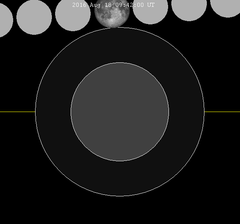 Predicted path of the eclipse; no eclipse actually occurred | |
| Date | 18 August 2016 (predicted) |
|---|---|
Background
The Earth's penumbral shadow is larger than would be expected from simple geometry, a phenomenon first observed by Philippe de La Hire in 1707. The precise amount of enlargement varies over time for reasons which are not fully understood, but likely involve the amount of dust in certain layers of the Earth's atmosphere.[1] Various eclipse almanacs have used different assumptions about the magnitude of this effect, resulting in disagreement about the predicted duration of lunar eclipses or, in the case of penumbral eclipses of very short duration, whether the eclipse will occur at all.[2]
In 1989, NASA published a lunar eclipse almanac that predicted a short penumbral lunar eclipse to occur on 18 August 2016. However, the French almanac Connaissance des Temps used more conservative assumptions about the size of the Earth's shadow and did not predict an eclipse to occur at all.[2] The Bureau des Longitudes in France continued to refine their lunar eclipse models; NASA's 2009 edition of its lunar eclipse almanac was based on their values,[3] which effectively reclassified nine eclipses between 1801 and 2300 as non-events, including the one in August 2016.[lower-alpha 1][4]
Some resources, including the HM Nautical Almanac Office's online canon of eclipses, continued to list the 18 August 2016 event.[5] Despite not appearing in NASA's printed lists of eclipses since the 2009 revision, AccuWeather reported the upcoming eclipse based on the Goddard Space Flight Center's online eclipse catalog.[6] Shortly before 18 August, the entry was removed from the Goddard website for Lunar Saros 109.[7]
Visibility

Had the original models been correct, this eclipse would have grazed the northern boundary of the Earth's penumbral shadow. The event was originally predicted to last 33 minutes and 36 seconds, beginning at 9:25 UTC and ending at 9:59. This would have produced a maximum penumbral magnitude of 0.0166.[8] Eclipses of such small magnitudes are visually imperceptible; a penumbral magnitude of approximately 0.6 is required for even skilled observers to detect.[9]
This slight dimming would have been visible from parts of Australia, Brazil, and eastern Canada.[5]
Related eclipses
Eclipses of 2016
- A total solar eclipse on March 9.
- A penumbral lunar eclipse on March 23.
- A penumbral lunar eclipse on August 18.
- An annular solar eclipse on September 1.
- A penumbral lunar eclipse on September 16.
Two penumbral lunar eclipses did occur in 2016, on 23 March and 16 September.
Lunar year series
| Lunar eclipse series sets from 2016–2020 | ||||||||
|---|---|---|---|---|---|---|---|---|
| Descending node | Ascending node | |||||||
| Saros | Date | Type Viewing |
Gamma | Saros | Date Viewing |
Type Chart |
Gamma | |
| 109 | 2016 Aug 18 |
Penumbral |
1.5641 | 114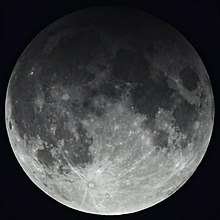 |
2017 Feb 11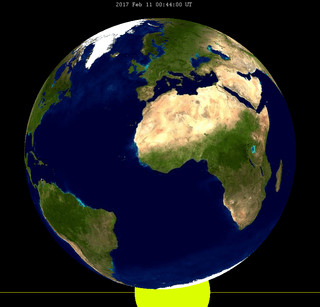 |
Penumbral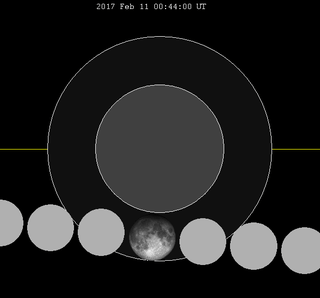 |
-1.0255 | |
119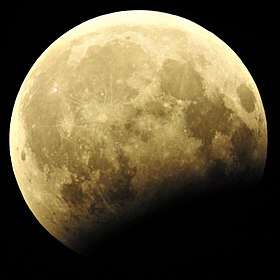 |
2017 Aug 07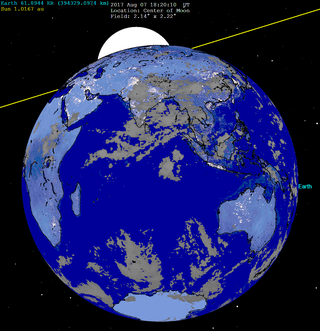 |
Partial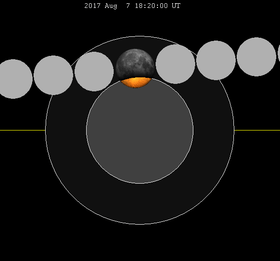 |
0.8669 | 124 |
2018 Jan 31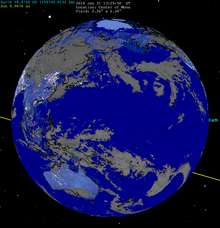 |
Total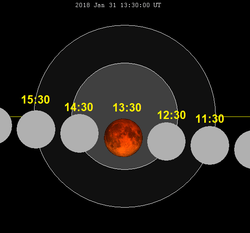 |
-0.3014 | |
129_(43696968392)_(cropped).jpg) |
2018 Jul 27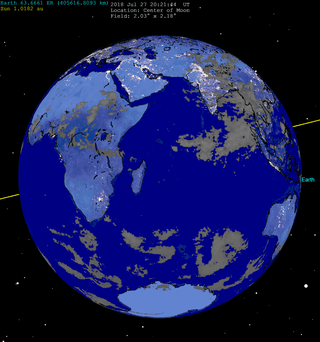 |
Total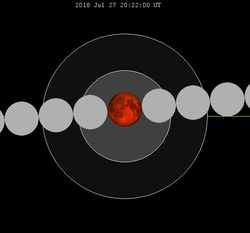 |
0.1168 | 134_(cropped).jpg) |
2019 Jan 21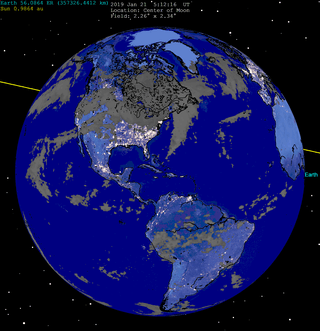 |
Total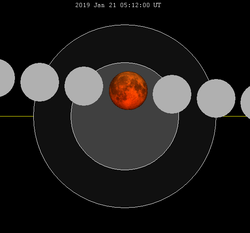 |
0.3684 | |
139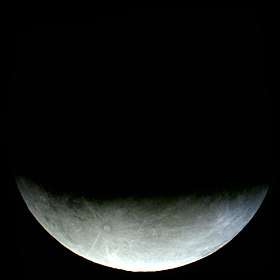 |
2019 Jul 16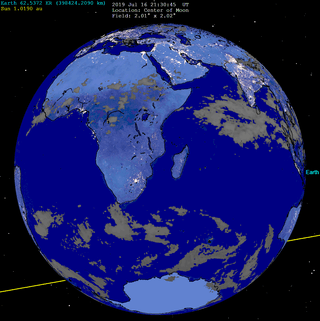 |
Partial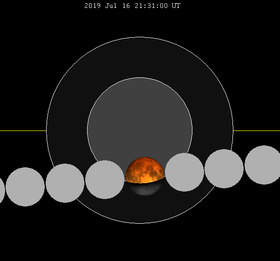 |
-0.6430 | 144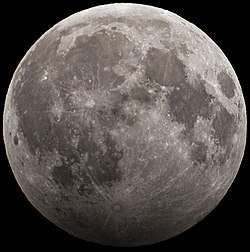 |
2020 Jan 10 |
Penumbral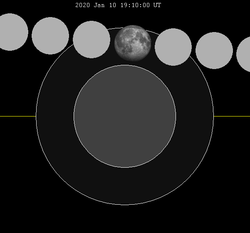 |
1.2406 | |
| 149 | 2020 Jul 05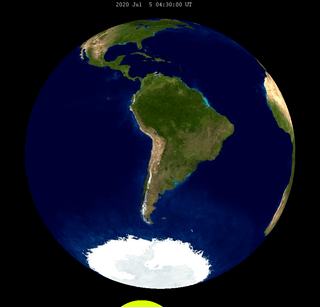 |
Penumbral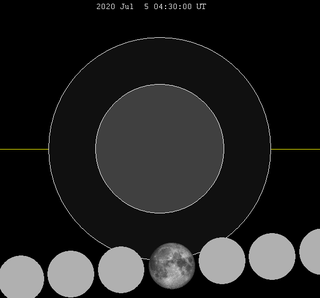 |
-1.3639 | |||||
| Last set | 2016 Sep 16 | Last set | 2016 Mar 23 | |||||
| Next set | 2020 Jun 05 | Next set | 2020 Nov 30 | |||||
Saros series
This eclipse would have been the last lunar eclipse of Saros cycle 109, and was originally listed as eclipse 73 (of 73) in that series.[8] Following revisions to models of the size of Earth's shadow, Saros 109 now includes only 71 events, with the last occurring on 8 August 1998.[10]
See also
- List of lunar eclipses
- List of 21st-century lunar eclipses
Notes
- The others are: 22 April 1864, 21 June 1872, 26 October 1882, 21 February 1951, 28 October 2042, 7 March 2194, 30 April 2219, and 18 February 2288.
References
- Espenak 1989, p. 205.
- Espenak 1989, p. 207.
- Espenak & Meeus 2009, p. v.
- Espenak & Meeus 2009, p. 10.
- "Penumbral Eclipse of the Moon: 2016 August 18". Canon of Eclipses. HM Nautical Almanac Office. 22 June 2018. Retrieved 11 January 2019.
- Lada, Brian. "Thursday's full moon: The lunar eclipse that no one will notice". AccuWeather. Retrieved 10 January 2019.
- Sutherland, Scott (17 August 2016). "An 'almost, maybe' lunar eclipse this week?". The Weather Network. Retrieved 10 January 2019.
- Espenak 1989, p. 150.
- Espenak & Meeus 2009, p. 11.
- "Catalog of Lunar Eclipse Saros Series: Saros Series 109". NASA Eclipse Web Site. Retrieved 11 January 2019.
Bibliography
- Espenak, Fred (1989). Fifty Year Canon of Lunar Eclipses: 1986–2035 (PDF). NASA. NASA Reference Publication 1216.CS1 maint: ref=harv (link)
- Espenak, Fred; Meeus, Jean (2009). Five Millennium Catalog of Lunar Eclipses: -1999 to +3000 (2000 BCE to 3000 CE) (PDF). NASA. NASA/TP-2009-213173.CS1 maint: ref=harv (link)
